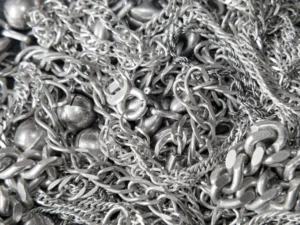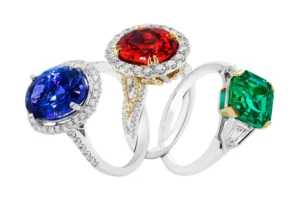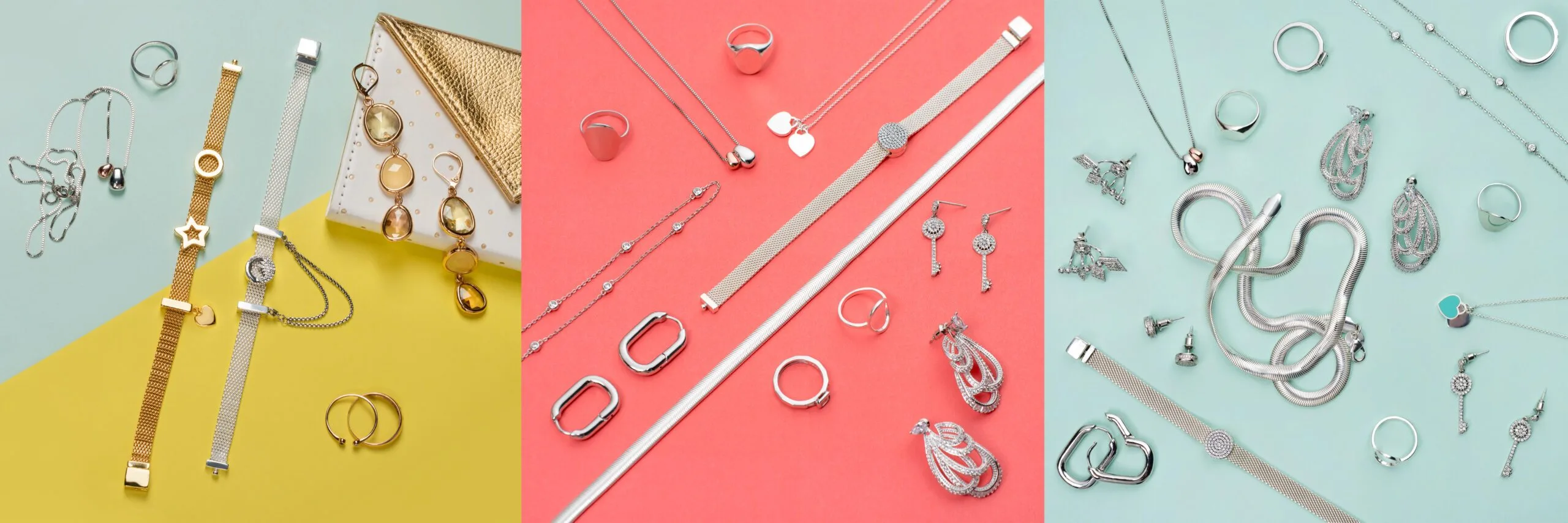Most people know white gold as a more affordable alternative to platinum. But platinum aside, white gold is a beautiful metal alloy in its own right! White gold was first invented in the 19th century, but it didn’t become widely known or commercially available until the 1920s. It then took off as a popular substitute for platinum jewelry, which was (and still is) rare and expensive.
Today white gold remains a popular metal choice for jewelry because it’s shiny, durable and versatile. But what exactly is white gold comprised of?
White Gold’s Popularity
White gold is an alloy of gold and various white metals – usually silver, nickel, platinum, and palladium. Not only do the white metals create a nice color when combined with gold, but they increase overall strength and durability, as pure gold is very soft on its own.
White gold is a common choice for engagement rings and wedding bands for several reasons. The neutral white color pairs well with everything and creates an ideal backdrop for gemstones. White gold is well-suited for a ring band, as it won’t distract the eye from a gemstone like a more colorful metal such as yellow gold might. White gold looks great with diamonds and other precious stones like sapphires, emeralds and rubies.
Platinum is also a popular engagement ring choice for the same aesthetic reasons, but it’s more expensive. White gold offers the best of both worlds – the appearance of platinum with a better price. And last but not least, white gold is strong and durable, making it suitable for jewelry that will be worn daily.

White Gold vs Silver
While silver has many different uses including industrial applications, white gold is primarily used for jewelry. White gold and silver may look similar at a glance, but silver is whiter in color. In fact, silver is the whitest and brightest of all metals – it has the highest reflectivity of visible light, making it useful for not just jewelry, but mirrors, solar panels and more!
White gold, however, will always have a faint yellow tint from the gold that it contains, and this will vary depending on the karat value. The higher the karat value of white gold, the more yellow-tinted it will appear. For example, 14k white gold will be whiter than 18k white gold, because it contains more white metals.
When it comes to durability, white gold is superior to silver jewelry. Pure silver is naturally soft and prone to tarnishing, which is why it’s often mixed with copper to increase strength in the classic sterling silver alloy.
The combination of gold, which is incredibly tarnish-resistant, with harder white metals makes white gold resistant to both corrosion and impact.
On the other hand, silver is more budget friendly. Although it will inevitably tarnish, silver jewelry can still be restored back to its original shine. All you need is a little patience and some silver polish!
White Gold vs Platinum
Platinum is the king of white metals in jewelry, as reflected in its price tag. With a quick search you’ll find tons of guides for choosing between white gold and platinum for engagement rings, wedding bands and more. One of the biggest factors to consider is that platinum is known for being hypoallergenic, whereas nickel allergies are a common issue with white gold jewelry. Jewelry containing nickel has been shown to trigger allergic reactions and skin irritation for some people. Even so, nickel is still often used because it’s generally the cheapest of the white metals used in white gold alloys. There are, of course, white gold alloys made without nickel, but you may have to shop around a bit more.
Platinum jewelry is typically very pure (usually around 95-98% pure platinum). Platinum’s purity makes it a bit easier to care for and maintain than white gold. White gold rings, for example, are often plated with a layer of rhodium, which may need to be replaced every few years.
How to Make White Gold
There are many ways for a metalsmith to make white gold. If you’re looking to go the allergy-friendly route, avoid using nickel and stick to platinum and/or palladium.
If you want the whitest possible appearance, a palladium-based alloy with a lower gold percentage (such as 10k or 14k) may be your best bet. White gold can be made from various combinations of gold and one or more white metals such as platinum, palladium, silver, nickel or even zinc. So when you think about it, the possibilities for different combinations and proportions are endless!

Rhodium Plating
Many white gold rings today are plated with a layer of rhodium, a rare bright silvery-white platinum group metal. Rhodium plating gives white gold rings a dazzling, diamond-like appearance that many consumers prefer. (Un-plated white gold, as aforementioned, naturally has a faint yellow tint.) Aside from a bright white finish, rhodium plating also adds a layer of protection against scratches.
Will White Gold Tarnish?
White gold doesn’t tarnish in the way that silver does. But if it’s plated with rhodium, the plating can wear away over time, leading to a loss of shine. The rhodium layer will need to be re-plated periodically.
To preserve rhodium-plated white gold jewelry, avoid contact with harsh chemicals such as chlorine, bleach, ammonia and other cleaning agents, as they can degrade the plating. And as with most jewelry, white gold can develop scratches on the surface from regular wear and tear. Scratches can be removed by polishing, but this should ideally be done by a professional.
Refining White Gold
White gold is a unique alloy with many redeeming qualities, making it a beloved choice for jewelry of all kinds. As a precious metal refinery with over a century in business, Garfield has received tons of shipments containing white gold over the years. From wedding bands to earrings, necklaces, bracelets, and even dental scrap, we’ve seen it all. Refining unwanted white gold ensures that all of the precious metals will be extracted and recycled – a win for both the seller and the environment. If you have unneeded white gold that you’re looking to monetize, we’ve got you covered!
Stay tuned to our blog for more insights on precious metals! If you liked this post, check out ‘Platinum: Jewelry’s Premier Precious Metal’ and ‘What’s the Value of My Antique Gold Jewelry?’
Considering selling your precious metal scrap? Garfield Refining will give you the highest payout for your gold, silver, platinum and palladium. Refining is as easy as the click of a button – download a free shipping label to get started today!

